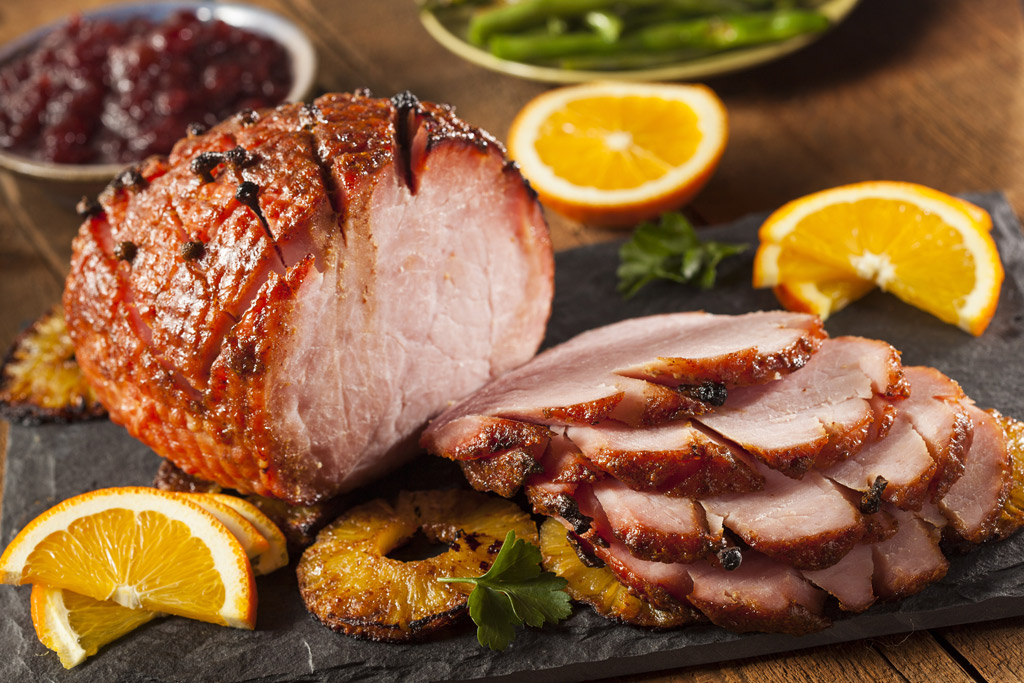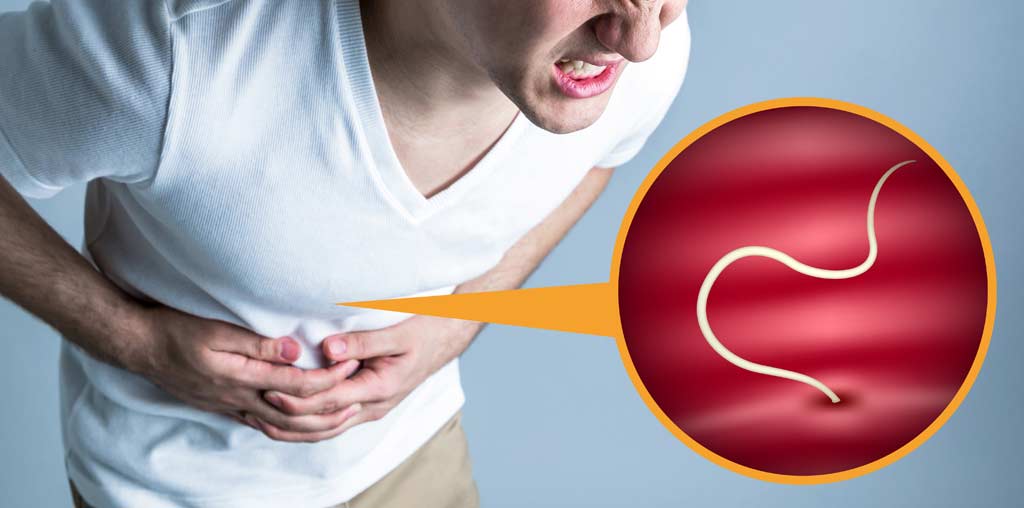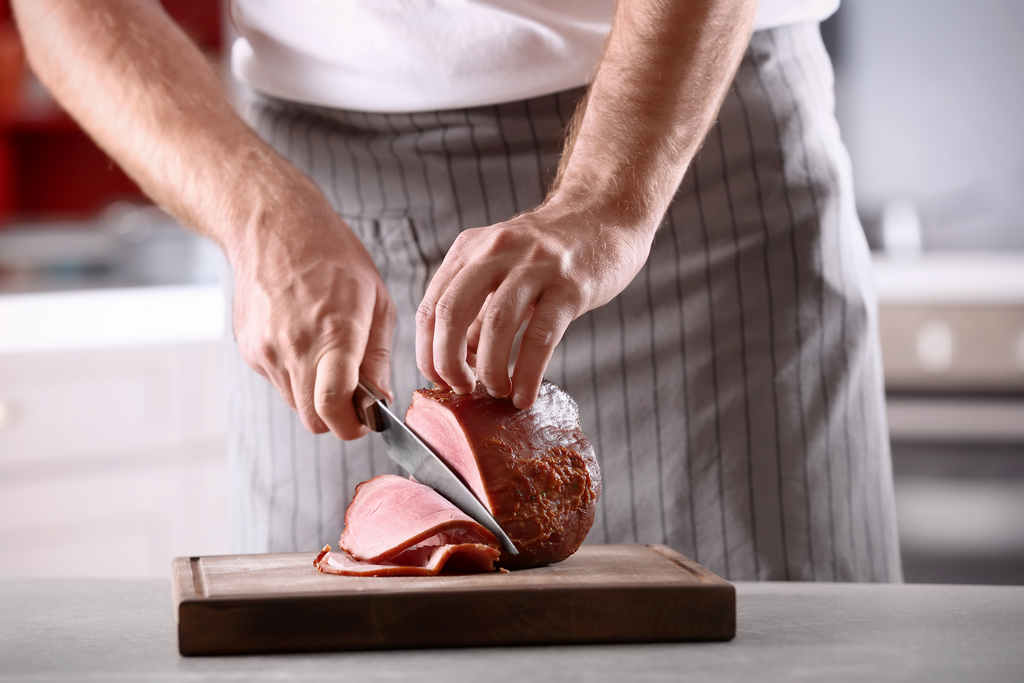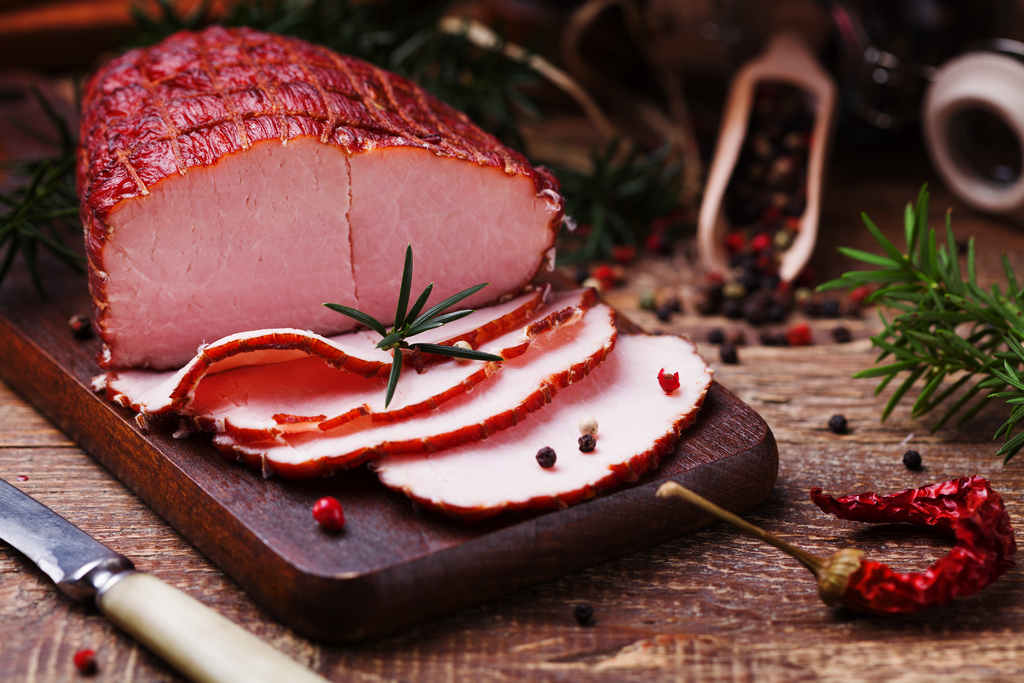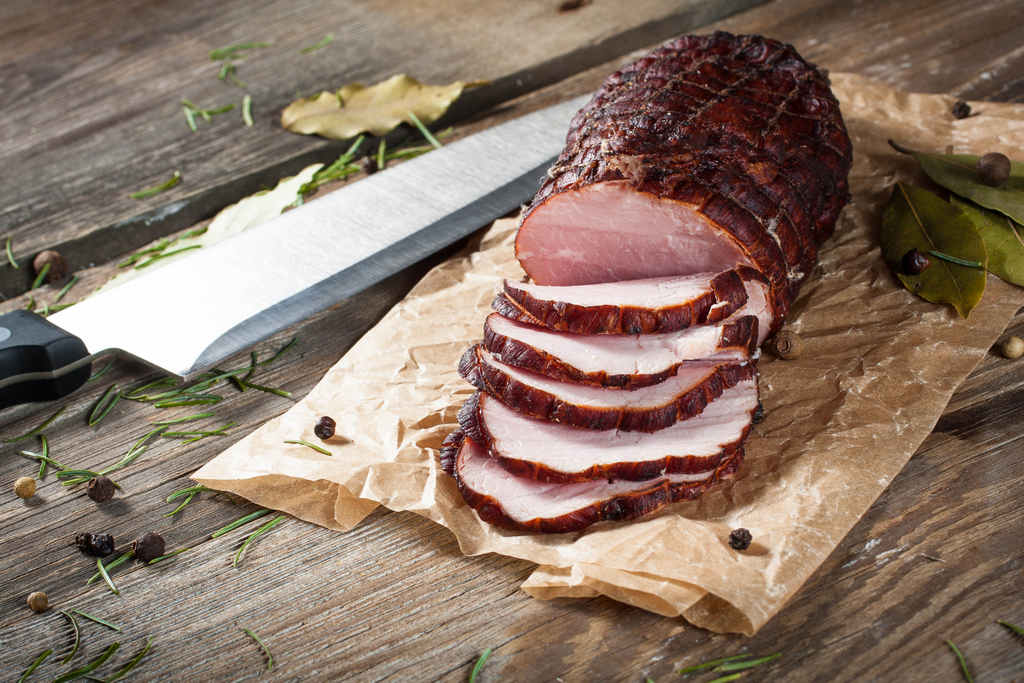Planning ahead for the holiday dinner? Make sure not to purchase the ham too soon. Some hams only keep for 3-4 days in the refrigerator.
Likewise, as with all meats, the safe preparation, the cooking of pork to the recommended temperature – and the proper storage of leftovers – must be done in order to prevent food illness.
Festive times for giving and sharing should not include sharing foodborne illness. Plan ahead the safe way by knowing the different storage times for hams!
Foodborne Pathogens Dangers in Pork
The foodborne pathogens (organisms in food that can cause disease) that can be found in pork, as well as other meats and poultry, are: Trichinella spiralis, Escherichia coli, Salmonella, Staphylococcus aureus, and Listeria monocytogenes.
- Learn about foodborne pathogens, cross contamination, cold and hot food safety, and best practices to prevent foodborne illness.
- Food Manager ANSI Certification: $99.00 - Valid in all States
- Food Handler Training: Only $7.00!
- 10% OFF: Enter Promo Code "train10off" at Checkout
People can become infected with these bacteria by consuming raw or undercooked pork, or from the cross-contamination of food contact surfaces, such as countertops, cutting boards, utensils.
The Centers for Disease Control and Prevention (CDC) says trichinosis infections are less common than previous decades because of better pork production laws. The parasitic illness is now more often associated with eating raw or undercooked wild game meats, such as wild boar and bear.
Symptoms include: nausea, diarrhea, abdominal cramps, followed later by muscle pain, weakness, fever, headache, and sometimes inflammation of other organs.
The USDA recommends cooking pork to an minimum internal temperature of 145°F – followed by a 3 minute rest time. Ground pork, like all ground meat, should be cooked to 160°F.
Buying Ham Times
Plan ahead the safe way by knowing the different storage times for hams: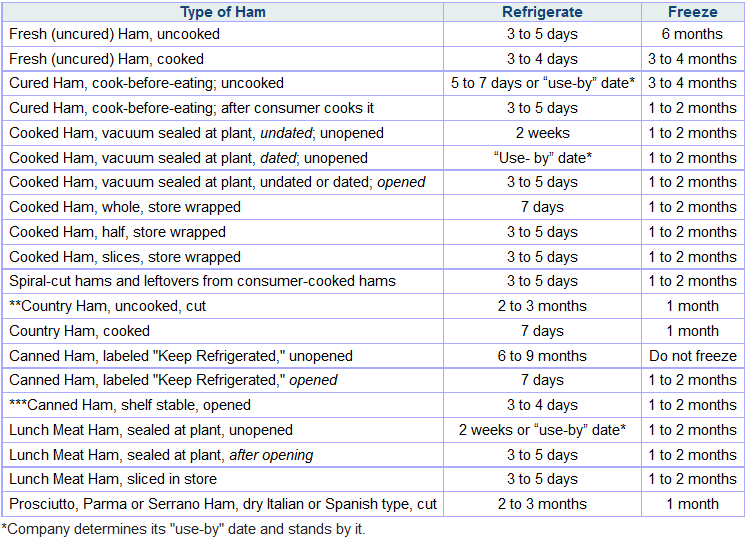
* Source: FoodSafety.gov
Food Safety Pork and Ham Tips
Remember to follow these important ham food safety tips for safe preparation and cooking:
Don’t Wash Your Pork or Ham
It isn’t necessary to wash raw pork before cooking it. Any bacteria which might be present on the surface would be destroyed by cooking.
Safely Thaw Your Ham
Never thaw at room temperature on the counter or in other locations. There are three safe ways to thaw pork:
- Refrigerator – It’s best to plan ahead for slow, safe thawing in the refrigerator. After thawing raw pork by this method, it will remain safe in the refrigerator 3 to 5 days before cooking. During this time, if you decide not to use the pork, you can safely refreeze it without cooking it first.
- Cold Water – Cold water thawing is faster than refrigerator thawing but requires more attention. Put ham in a leak-proof package or plastic bag and submerge it in cold tap water, changing the water every 30 minutes. Estimate about 30 minutes per pound of ham. If thawed completely by the cold water method, the food must be cooked immediately.
- Microwave – When microwave-defrosting pork, plan to cook it immediately after thawing because some areas of the food may become warm and begin to cook during microwaving. Holding partially cooked food is not recommended because any bacteria present wouldn’t have been destroyed. Foods defrosted in the microwave or by the cold water method should be cooked before refreezing because they potentially may have been held at temperatures above 40°F.For additional microwave thawing information, please refer to your owner’s manual. For more information about thawing: The Big Thaw — Safe Defrosting Methods for Consumers (PDF).
It is safe to cook frozen pork in the oven, on the stove or grill without defrosting it first; the cooking time may be about 50% longer. Use a meat thermometer to check for doneness. Do not cook frozen pork in a slow cooker.
Safe Cooking of Pork and Ham
For safety, the USDA recommends minimum cooking temperatures – as measured with a food thermometer:
- Ground pork patties and ground pork mixtures such as meat loaf to 160°F.
- Raw pork steaks, chops, and roasts to a minimum internal temperature of 145°F.
For safety and quality, allow meat to rest for at least 3 minutes before carving or consuming. For reasons of personal preference, consumers may choose to cook meat to higher temperatures.
| Cut | Temperature |
|---|---|
| Pork Loin/Tenderloin | 145°F – 160°F |
| Pork Chop | 145°F – 160°F |
| Ham | 145°F |
| Ribs | 145°F – 160°F |
| Ground Pork | 160°F |
| Pork Shoulder | 145°F – 160°F |
| Cutlets | 145°F – 160°F |
* Source: FoodSafety.gov
Following these pork cooking temperature guidelines will not only result in a safe eating experience, but also preserve the quality of your meat for a juicy, tender, delicious meal.
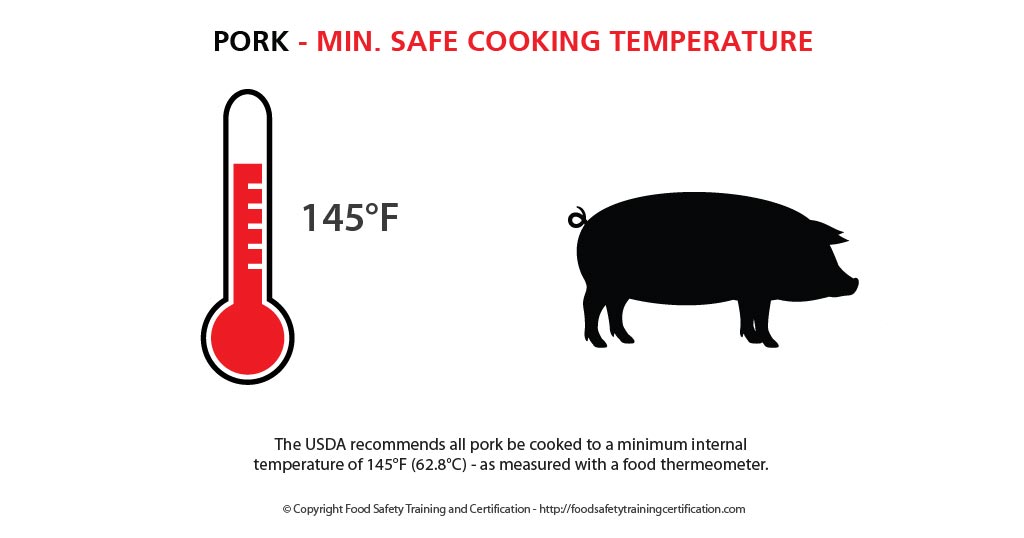
Leftovers (General Rule: 2-4-4)
Cut the ham off the bone and refrigerate it within 2 hours of the ham coming out of the oven. Leftovers will last for 4 days in the refrigerator, so if you know you won’t use them right away, pack them into freezer bags or airtight containers and freeze. For best quality, use your leftover frozen ham within 4 months.
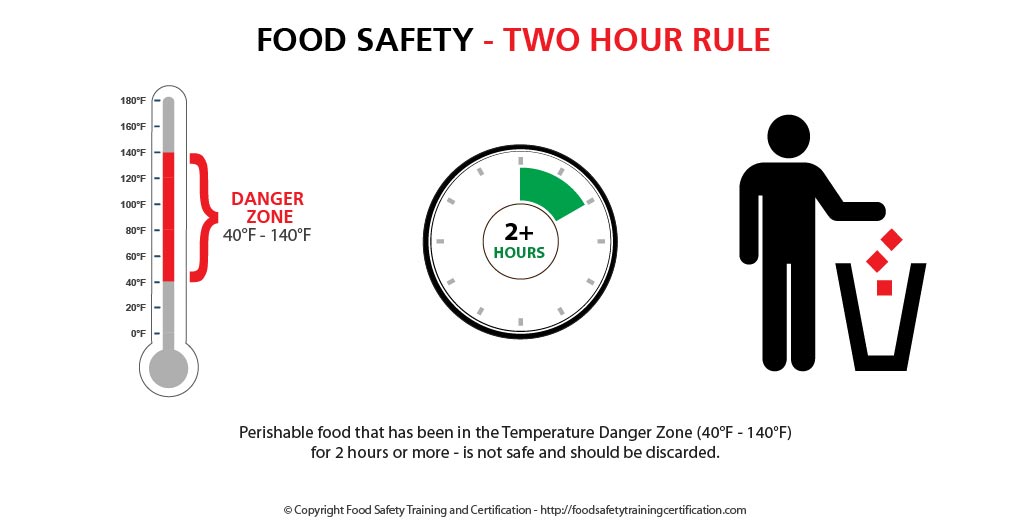
Home Storage of Fresh Pork
These short, but safe, storage time limits will help keep refrigerated food from spoiling or becoming dangerous to eat. Because freezing keeps food safe indefinitely, recommended storage times are for quality only. Source: National Pork Board
How long can I keep my fresh pork in the refrigerator?
Sealed, pre-packed fresh pork cuts can be kept in the refrigerator 2 to 4 days; sealed ground pork will keep in the refrigerator for 1 to 2 days. If you do plan on keeping the raw, fresh pork longer than 2 to 3 days before cooking it, store it well-wrapped in the freezer.
What length of time can I keep pork in the freezer?
Generally, fresh cuts of pork, like roasts, chops and tenderloin can be kept well-wrapped in the freezer up to six months. Well-wrapped ground pork can be kept for about three months in the freezer.
What about freezing ham?
The National Pork Board does not encourage freezing cooked ham, since it affects the quality and texture of the meat. However, leftover ham for use in soups or casseroles can be cut up into slices or cubes and stored in the freezer for 2 to 3 months.
Pork and Agricultural Resources
- Ag Chat Foundation
- Ag on the Forefront
- Agricultural Entrepreneurship
- Agriculture Proud
- AgWeb
- American Association of Meat Processors
- American Association of Swine Practitioners
- Beyer Beware
- Big Picture Agriculture
- Farmer Bloggers
- Farm Girl with Curls
- FarmHer
- Farm Policy
- Food Swine Iowa
- Mom at the Meat Counter
- National Sustainable Agriculture Coalition
- PRV Fact Sheets (Pork Board)
- SwineWeb
- The Food Dialogues
- The Western Producer
- Think Forward Blog
- USDA Blog
- Why I Farm
Ham Glossary
CANNED HAM: “Canned meat with Natural Juices” is acceptable for product that has been pumped or contains up to 10% of a solution before canning and processing. Processed, canned, uncured meat products (when water or broth is added to the can) may not be called “with natural juices.” The acceptable name would be “with juices.” Canned hams come in two forms:
- Shelf stable – Can be stored on the shelf up to 2 years at room temperature. Generally not over 3 pounds in size. Processed to kill all spoilage bacteria and pathogenic organisms such as Clostridium botulinum, Salmonella and Trichinella spiralis. The product is free of microorganisms capable of growing at ordinary room temperature. However, high temperature storage — above 122 °F (50 °C) — may result in harmless thermophylic bacteria multiplying and swelling or souring the product.
- Refrigerated – May be stored in the refrigerator for up to 6 to 9 months. Its weight can be up to 8% more than original uncured weight due to the uptake of water during curing. It need not be labeled “Added water” except for “In Natural Juices.” Net Weight is the weight of the actual ham excluding the container. Processed at a cook time and temperature sufficient to kill infectious organisms (including trichinae); however, the ham is not sterilized so spoilage bacteria may grow eventually.
CAPACOLLO, COOKED (Capicola, Capocolla, Capacola, Capicollo, Cappicola, Capacolo – Italian): This product does not meet the definition of ham because it is not from the hind leg of a hog. It is boneless pork shoulder butts which are cured and then cooked. The curing process may be dry curing, immersion curing, or pump curing. The cured product is coated with spices and paprika before cooking. This product shall always be labeled with “Cooked” as part of the product name. Water added is permitted.
CAPACOLLA, HAM, COOKED: Ham that has been cured and then cooked.
COOK BEFORE EATING: Needs cooking or further cooking. Is not cooked in the plant or heat treated in the plant and should be cooked to a safe minimum internal temperature of 160 °F.
COTTAGE “HAM”: A cut from the top end of the shoulder, known as the shoulder butt, which has been cured in brine. Because it is not from the hind leg of the hog, it doesn’t meet the definition of ham. The meat is not cooked. Another term for it is “cottage roll.”
COUNTRY HAM, COUNTRY STYLE HAM, or DRY CURED HAM, and COUNTRY PORK SHOULDER, COUNTRY STYLE PORK SHOULDER, or DRY CURED PORK SHOULDER: The uncooked, cured, dried, smoked or unsmoked meat food products made respectively from a single piece of meat conforming to the definition of “ham,” or from a single piece of meat from a pork shoulder. They are prepared by the dry application of salt or by salt and one or more optional ingredients: nutritive sweeteners, spices, seasonings, flavorings, sodium or potassium nitrate, and sodium or potassium nitrite. They may not be injected with curing solutions nor placed in curing solutions. The product must be treated for the destruction of possible live trichinae.
FULLY COOKED or COOKED: Needs no further cooking because it is fully cooked at the establishment where it was produced and packaged. Product can be eaten right out of the package or reheated. Fully cooked is synonymous with cooked.
GELATIN: Gelatin is a binder/extender and is only permitted in a few meat and poultry products like sausage, luncheon meat, and meat loaves. About 1/4 ounce of dry gelatin is often added before a canned ham is sealed to cushion the ham during shipment. During processing, natural juices cook out of the ham and combine with the gelatin. When the ham cools, a jell forms. Gelatin is included in the net weight statement on the label and its presence is also qualified in the product name, e.g., Canned Ham, Gelatin Added.”
HALF HAM: “Half Ham” is permitted on labels for semi-boneless ham products which have had the shank muscles removed during processing. The two halves of the finished product have approximately an equal amount of bone. The term “No Slices Removed” has also been deemed suitable for use with a ham item referred to as “Half Ham.”
HAM: Cured leg of pork. In order to be labeled as “Ham,” the product must be at least 20.5% protein in lean portion as described in 9 CFR 319.104. Added water is permitted in a product labeled as “Ham.” In fact, water will be declared in order of predominance in the ingredients statement. This is how the cure solution is introduced into a ham.
HAM AND WATER PRODUCTS X% of Weight is Added Ingredients: Product contains more additives than a “Ham Water Added,” but the product name must indicate percent of “added ingredients.” For example, “Ham and Water Product 25% of Weight is Added Ingredients” for any canned ham with less than 17.0% protein.
HAM, BOILED: A fully cooked, boneless product which must be cooked in water and may be processed in a casing or can. The product may be of various shapes and may be partially cooked in boiling water.
HAM, FRESH (or uncured): The uncured leg of pork. Since the meat is not cured or smoked, it has the flavor of a fresh pork loin roast or pork chops. Its raw color is pinkish red and after cooking, grayish white. Ham that does not contain a cure must be labeled either “Fresh” or “Uncured” – prepared without nitrate or nitrite. This also applies to cooked product, and must be labeled cooked product “Cooked Uncured Ham.”
HAM SALAD: Product must contain at least 35% cooked ham. Chopped ham may be used without it appearing in the product name.
HAM, SCOTCH STYLE: A cured, uncooked, boned, and rolled whole ham either tied or in a casing.
HAM SHANK END, HAM SHANK HALF or HAM SHANK PORTION: The lower, slightly pointed part of the leg. A “portion” has the center slices removed for separate sale as “ham steaks.” A half ham does not have slices removed.
HAM, SKINLESS, SHANKLESS: A ham with all of the skin and the shank removed. The leg bone and aitch (hip) bone remain.
HAM, SMITHFIELD: This is an aged, dry-cured ham made exclusively in Smithfield, Virginia. The use of the words “brand” or “style,” e.g., “Smithfield Brand Ham,” “Smithfield Style Ham,” does not eliminate this requirement.
HAM STEAK: Another name for ham slices.
HAM – WATER ADDED: The product is at least 17.0% protein with 10% added solution.
HAM with NATURAL JUICES: The product is at least 18.5% protein.
HICKORY-SMOKED HAM: A cured ham which has been smoked by hanging over burning hickory wood chips in a smokehouse. May not be labeled “hickory smoked” unless hickory wood has been used. Atomized liquid hickory smoke and heat can combine to produce “hickory smoke.”
HONEY-CURED: May be shown on the labeling of a cured product if (1) the honey used contains at least 80% solids or is U.S. grade C or above; (2) honey is the only sweetening ingredient or when other sweetening ingredients are used in combination with honey, they do not exceed 1/2 the amount of honey used; and (3) honey is used in an amount sufficient to flavor and/or affect the appearance of the finished
product.
“LEAN” HAM: The term “lean” may be used on a ham’s label provided the product contains less than 10 grams fat, 4.5 grams or less of saturated fat, and less than 95 milligrams cholesterol per 100 grams and Reference Amount Customarily Consumed (RACC).
“EXTRA LEAN” HAM: A ham labeled “extra lean” must contain less than 5 grams fat, less than 2 grams saturated fat and the same cholesterol as allowed per the amount of “lean” ham.
PORK SHOULDER PICNIC: A front shoulder cut of pork. The term “picnic” cannot be used unless accompanied with the primal or subprimal cut. Pork shoulder picnic is not always a cured item. A shoulder “picnic” comes from the lower portion of the shoulder.
PROSCIUTTO: Italian for ham, dry cured. The product name “Prosciutto” is acceptable on labeling to identify a dry-cured ham. An Italian-style dry cured raw ham; not smoked; often coated with pepper. Prosciutto can be eaten raw because the low water content prevents bacter
ial growth. PARMA HAM is prosciutto from the Parma locale in Italy. These hams tend to be larger than the U.S. produced product, as Italian hogs are larger at slaughter.
PROSCIUTTO, COOKED: The product name “Cooked Prosciutto” is acceptable on labeling to identify a Prosciutto that is cooked.
SECTIONED AND FORMED HAM or CHUNKED AND FORMED HAM: A boneless ham that is made from different cuts, tumbled or massaged and reassembled into a casing or mold and cooked. During this process it is usually thoroughly defatted. The qualifying phrase “sectioned and formed” is no longer required on boneless ham products, e.g., “ham” and “ham-water added.” The addition of small amounts of ground ham added as a binder to such products may be used without declaration. The amount of ground ham that may be used can represent no more than 15% of the weight of the ham ingredients at the time of formulation. Products containing more than 15% ground ham trimmings must be labeled to indicate the presence of the ground ham, e.g., “a portion of ground ham added.”
SUGAR CURED: May be used on the labeling of a cured product (1) if the sugar used is cane sugar or beet sugar; (2) sugar is the only sweetening ingredient or when other sweetening ingredients are used in combination with sugar, they do not exceed one-half the amount of sugar used; and (3) sugar is used in an amount sufficient to flavor and/or affect the appearance of the finished product.
WESTPHALIAN HAM: A German-style dry-cured ham that is similar to Prosciutto; smoked, sometimes made with juniper berries.
NOTE: Most of the definitions in this glossary are from the FSIS “Food Standards and Labeling Policy Book.” To access this book, go to: http://www.fsis.usda.gov/wps/wcm/connect/7c48be3e-e516-4ccf-a2d5-b95a128f04ae/Labeling-Policy-Book.pdf?MOD=AJPERES (PDF Only).

